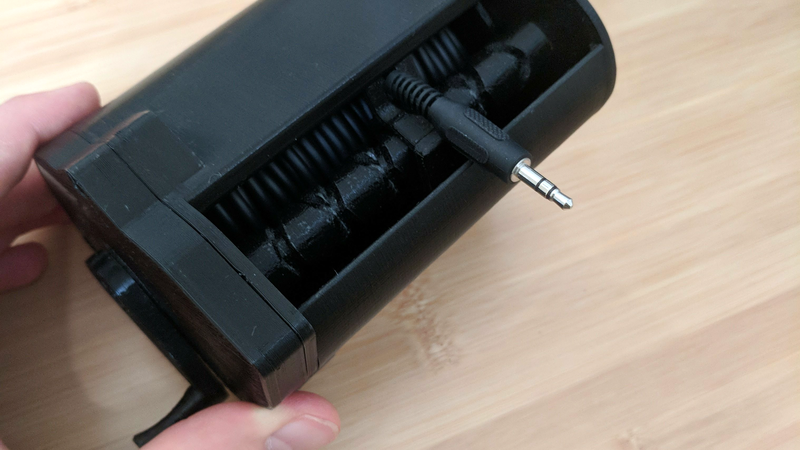Long cables are only neat once – before they’re first unwrapped. Once that little cable tie is taken off, a cable is more likely to end up rats-nested than neatly coiled.
Preventing that is the idea behind this 3D-printed cable reel. The cable that [Kevin Balke] wants to make easier to deal with is a 50 foot (15 meters) long Vive lighthouse sync cable. That seems a bit much to us, but it makes sense to separate the lighthouses as much as possible and mount them up high enough for the VR system to work properly.
[Kevin] put a good deal of effort into making this cable reel, which looks a little like an oversize baitcasting-style fishing reel. The cable spool turns on a crank that also runs a 5:1 reduction geartrain powering a shaft with a deep, shallow-pitch crossback thread. An idler runs in the thread and works back and forth across the spool, laying up the incoming cable neatly. [Kevin] reports that the reciprocating mechanism was the hardest bit to print, as surface finish affected the mechanism’s operation as much as the geometry of the mating parts. The video below shows it working smoothly; we wonder how much this could be scaled up for tidying up larger cables and hoses.
This is another great entry in our 3D Printed Gears, Pulleys, and Cams Contest. The contest runs through February 19th, so there’s still plenty of time to get your entries in. Check out [Kevin]’s entry along with all the others, and see what you can come up with.
















It’s an interesting idea but between the tension and the tightness of the loop, this will shorten the cable life. You can avoid all of this and have a tidy cable by using this technique: https://www.youtube.com/watch?v=edWQfNnj5P4
I’m working in the entertainment industry and have worked on big productions like an AC/DC concert.
But I’ve never met a technician or a rental company that does this technique. They all know about it but no one I know has ever used it.
I was taught the over-under technique, and still use it. Haven’t done any BIG concerts, but still.
I’m from Nashville and grew up around studios. You _always_ under-over good cable if you care about shorts/hum/cable life. Maybe it’s a studio thing?
My experience with cables is that the smaller they are, the less “lay” they have. Or probably more correctly, in smaller cables the stiffness of the jacket is greater than the force exerted by the twist of the conductors inside. That over-under twist technique works well for larger-diameter cables with good quality jackets, but I’ve never had much luck introducing the twist into little PVC-jacketed cables like the Vive sync cord shown.
That said, yes, the diameter of the spool could be a touch bigger to reduce strain on the cable. But that’s the beauty of 3D-printing, right? Version 2 is only a couple of printing hours away.
Learned this wiring internet drops for conventions for a few years. The boss had been a roadie. The best part that the video never showed was that if you hold onto the end of one of these cables and throw the coil, it unwinds and lays flat without tangling.
They even teach rolling elbow and shoulder in Scouts. It’s appalling how many times new employees have to be reeducated on not making a mess for the rest of us, especially with hoses.
In this project’s case the cord will not lay-flat (town nickname), a wavy loopy toe-catching mess on the floor. Quack, duck tape. For 50 feet of this cable this should be a drum of more than 1 foot diameter, then looping is reduced.
When wires don’t lay flat they have memory of the twisted state. Best case are those 2 conductor cords that end up having a twist of many turns per foot. I learned about the right way form a stage hand who could throw a long cable from the stage to the second balcony, no tangles mid-air. Get it done quick now to hell with later undoing. Packing a ‘chute is the best example of the proper way. Even a short cord of a saw or drill can’t be wound on the tool.
The level wind part of this could be adapted to a printer filament extruder spooler.